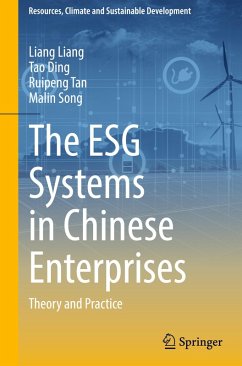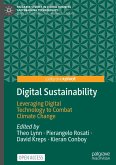- Gebundenes Buch
- Merkliste
- Auf die Merkliste
- Bewerten Bewerten
- Teilen
- Produkt teilen
- Produkterinnerung
- Produkterinnerung
This book delves deeply into the ESG (Environmental, Social, and Governance) management systems of Chinese enterprises. It systematically analyzes the origins and evolution of ESG, taking into account China's unique policy environment and market demands, and presents a localized ESG management framework tailored to Chinese companies. The book provides numerous case studies that illustrate how to effectively implement these frameworks in business operations, offering concrete guidance for achieving sustainable development.
This book covers all aspects of ESG management, including comparisons…mehr
Andere Kunden interessierten sich auch für
![Corporate Governance und Strategie. Die Verknüpfung von CG und einer nachhaltig erfolgreichen Unternehmensstrategie Corporate Governance und Strategie. Die Verknüpfung von CG und einer nachhaltig erfolgreichen Unternehmensstrategie]() Artur JankeCorporate Governance und Strategie. Die Verknüpfung von CG und einer nachhaltig erfolgreichen Unternehmensstrategie18,95 €
Artur JankeCorporate Governance und Strategie. Die Verknüpfung von CG und einer nachhaltig erfolgreichen Unternehmensstrategie18,95 €![Implementation of Corporate Social Responsibility at 3M Czech Republic Implementation of Corporate Social Responsibility at 3M Czech Republic]() Marek BogdanImplementation of Corporate Social Responsibility at 3M Czech Republic42,95 €
Marek BogdanImplementation of Corporate Social Responsibility at 3M Czech Republic42,95 €![Transition Towards a Sustainable Future Transition Towards a Sustainable Future]() Transition Towards a Sustainable Future136,99 €
Transition Towards a Sustainable Future136,99 €![Transformative Governance for the Future Transformative Governance for the Future]() Antonia Caro-GonzalezTransformative Governance for the Future23,99 €
Antonia Caro-GonzalezTransformative Governance for the Future23,99 €![Digital Sustainability Digital Sustainability]() Digital Sustainability38,99 €
Digital Sustainability38,99 €![Food Policy Modelling Food Policy Modelling]() Food Policy Modelling76,99 €
Food Policy Modelling76,99 €![Food Policy Modelling Food Policy Modelling]() Food Policy Modelling76,99 €
Food Policy Modelling76,99 €-
-
-
This book delves deeply into the ESG (Environmental, Social, and Governance) management systems of Chinese enterprises. It systematically analyzes the origins and evolution of ESG, taking into account China's unique policy environment and market demands, and presents a localized ESG management framework tailored to Chinese companies. The book provides numerous case studies that illustrate how to effectively implement these frameworks in business operations, offering concrete guidance for achieving sustainable development.
This book covers all aspects of ESG management, including comparisons of international standards, analysis of policy and legal frameworks, investment decisions, and corporate risk management. It is suitable for a diverse audience, including scholars, government officials, and corporate managers. By integrating theory with practice, the book provides forward-looking recommendations, offering strong practical guidance through case studies and empirical research to help companies improve their ESG management systems.
This book covers all aspects of ESG management, including comparisons of international standards, analysis of policy and legal frameworks, investment decisions, and corporate risk management. It is suitable for a diverse audience, including scholars, government officials, and corporate managers. By integrating theory with practice, the book provides forward-looking recommendations, offering strong practical guidance through case studies and empirical research to help companies improve their ESG management systems.
Produktdetails
- Produktdetails
- Resources, Climate and Sustainable Development
- Verlag: Springer / Springer Nature Singapore / Springer, Berlin
- Artikelnr. des Verlages: 978-981-96-5458-1
- Seitenzahl: 468
- Erscheinungstermin: 29. April 2025
- Englisch
- Abmessung: 241mm x 160mm x 31mm
- Gewicht: 807g
- ISBN-13: 9789819654581
- ISBN-10: 9819654580
- Artikelnr.: 73573049
- Herstellerkennzeichnung
- Springer-Verlag GmbH
- Tiergartenstr. 17
- 69121 Heidelberg
- ProductSafety@springernature.com
- Resources, Climate and Sustainable Development
- Verlag: Springer / Springer Nature Singapore / Springer, Berlin
- Artikelnr. des Verlages: 978-981-96-5458-1
- Seitenzahl: 468
- Erscheinungstermin: 29. April 2025
- Englisch
- Abmessung: 241mm x 160mm x 31mm
- Gewicht: 807g
- ISBN-13: 9789819654581
- ISBN-10: 9819654580
- Artikelnr.: 73573049
- Herstellerkennzeichnung
- Springer-Verlag GmbH
- Tiergartenstr. 17
- 69121 Heidelberg
- ProductSafety@springernature.com
Liang Liang, professor, doctor, doctoral supervisor. He previously served as the president of Hefei University of Technology. In recent years, he is mainly engaged in the research of data envelopment analysis, supply chain management and enterprise digital transformation, which has made a certain impact over the world. He has published more than 300 papers in high level journals such as Operations Research, Operations Research, Journal of Operations Management, IEEE Tran. On SMC, OMEGA, IIE Transactions, Naval Research Logistics and so on. Tao Ding, doctor of Management, associate professor and master supervisor of School of Economics, Hefei University of Technology, visiting scholar of Worcester Institute of Technology, USA. He mainly engages in the research of evaluation technology and methods, regional economy, ecological economy and green finance. He has published more than 50 high level papers in the journals such as OMEGA, Annals of Operations Research, Energy Economics, Socio-economic Planning Sciences, Computational Economics and so on. He has also published 5 academic books in the field of environmental economics and resources management. Ruipeng Tan, doctor of Economics, professor and master supervisor of School of Economics, Hefei University of Technology. He mainly engages in the research of ESG evaluation, energy economics and environmental economics. He has published more than 30 high level papers in the journals such as Journal of Development Economics, Energy Economics, Transport Policy, Journal of Environmental Management and so on Malin Song, professor, doctor (post), doctoral supervisor. In recent years, he is mainly engaged in the research of data envelopment analysis and environmental economic statistics, especially in the evaluation methods and applications of environmental efficiency, which has made a certain impact over the world. He has published more than 300 papers in high level journals such as OMEGA, Annals of Operations Research, Journal of Environmental Management and so on. He has also published more than 10 books in the field of environmental economics and resources management.
.- Chapter 1: Introduction
.- 1.1 The origin, development, and connotation of the ESG concept
.- 1.2 Background of the rise of ESG management in China
.- 1.3 The research purpose, significance and content of this book
.- Chapter 2: International ESG Standards and Frameworks
.- 2.1 Overview of International Mainstream Disclosure Standards
.- 2.2 Global Leading ESG Rating Agencies and Their Methodologies
.- 2.3 Impact of International ESG Development trends on China
.- Chapter 3: ESG Policies and Regulatory Environment in China
.- 3.1 The Dual Carbon Strategy and the Evolution of ESG Policies in China
.- 3.2 Regulatory Framework and Institutional Development of ESG in China
.- 3.3 Impact of Regulatory Requirements on Corporate ESG Practices
.- Chapter 4: Establishing an ESG Management Framework for Chinese Enterprises
.- 4.1 Introduction
.- 4.2 ESG Strategy Planning and Integration
.- 4.3 ESG Organizational Structure
.- 4.4 ESG Risk Management
.- 4.5 Summary
.- Chapter 5: Environmental (E) Dimension Management
.- 5.1 Corporate Objectives under Environmental Policies: A Case Study in China
.- 5.2 Environmental Governance and Policy Compliance
.- 5.3 Carbon Emissions and Energy Management in Enterprises
.- 5.4 Climate Risk Management
.- Chapter 6: Management of the Social (S) Dimension
.- 6.1 Corporate Social Responsibility and Business Development
.- 6.2 Community Engagement and Development
.- 6.3 Protection of Labor Rights and Employee Development
.- 6.5 Social Welfare and Philanthropy
.- Chapter 7: Management of the Governance (G)
.- 7.1 The Connotation and Significance of Corporate Governance
.- 7.2 Organizational Structure and Responsibilities
.- 7.3 Risk Management and Internal Control
.- 7.4 Stakeholder Relationship Management
.- 7.5 Exploration of the Governance Dimension in China's ESG System
.- Chapter 8: ESG Performance Evaluation and Reporting
.- 8.1 Design and Measurement of ESG Performance Metrics
.- 8.2 Principles and Framework for ESG Reporting
.- 8.3 Authenticity and Effectiveness of ESG Reporting
.- 8.4 Summary
.- Chapter 9: ESG Investment and Capital Markets
.- 9.1 Overview of ESG products in the Chinese Capital Market
.- 9.2 ESG, innovation and stock price synchronicity
.- 9.3 The role of ESG factors in investment decisions
.- Chapter 10: The Impact of New Generation Information Technology on Enterprise ESG
.- 10.1 The Impact of Big Data on Corporate ESG
.- 10.2 The impact of AI on ESG
.- 10.3 The Impact of IoT Technology on ESG
.- 10.4 The Impact of Blockchain Technology on ESG
.- 10.5 Summary
.- Chapter 11: ESG Best Practices for Chinese Companies
.- 11.1 Corporate ESG Management
.- 11.2 ESG Excellence in Practice
.- 11.3 Specific Innovation Practices Toward a Dual Carbon Goal--The Case of Lenovo Group
.- 11.4 From challenges to opportunities: ESG-driven business transformation
.- Chapter 12: A Comparison of Practice and Industry Differences in ESG
.- 12.1 Reasons and characteristics of differences in the ESG industry
.- 12.2 Differential development of ESG in various industries in China
.- 12.3 Impact and enlightenment of ESG industry differences
.- 12.4 Practical Comparison of ESG Industry Differences
.- Chapter 13: ESG Disclosure and Stock Price Crash Risk
.- 13.1 Introduction
.- 13.2 Literature review and hypothesis development
.- 13.3 Data and variables
.- 13.4 Empirical results
.- 13.5 Further analysis
.- 13.6 Summary
.- Chapter 14: ESG Rating Divergence and Corporate Debt Financing Cost: Based on Chinese ESG Rating Agency Data
.- 14.1 Background and literature review
.- 14.2 Research design
.- 14.3 Primary results
.- 14.4. Conclusions and policy implications
.- Chapter 15: Future Prospect and Strategy Recommendations
.- 15.1 Opportunities and Challenges Faced by China's ESG Sector
.- 15.2 Strategic suggestions for promoting the localization of ESG development
.- 15.3 Building an ESG ecosystem with Chinese characteristics.
.- 1.1 The origin, development, and connotation of the ESG concept
.- 1.2 Background of the rise of ESG management in China
.- 1.3 The research purpose, significance and content of this book
.- Chapter 2: International ESG Standards and Frameworks
.- 2.1 Overview of International Mainstream Disclosure Standards
.- 2.2 Global Leading ESG Rating Agencies and Their Methodologies
.- 2.3 Impact of International ESG Development trends on China
.- Chapter 3: ESG Policies and Regulatory Environment in China
.- 3.1 The Dual Carbon Strategy and the Evolution of ESG Policies in China
.- 3.2 Regulatory Framework and Institutional Development of ESG in China
.- 3.3 Impact of Regulatory Requirements on Corporate ESG Practices
.- Chapter 4: Establishing an ESG Management Framework for Chinese Enterprises
.- 4.1 Introduction
.- 4.2 ESG Strategy Planning and Integration
.- 4.3 ESG Organizational Structure
.- 4.4 ESG Risk Management
.- 4.5 Summary
.- Chapter 5: Environmental (E) Dimension Management
.- 5.1 Corporate Objectives under Environmental Policies: A Case Study in China
.- 5.2 Environmental Governance and Policy Compliance
.- 5.3 Carbon Emissions and Energy Management in Enterprises
.- 5.4 Climate Risk Management
.- Chapter 6: Management of the Social (S) Dimension
.- 6.1 Corporate Social Responsibility and Business Development
.- 6.2 Community Engagement and Development
.- 6.3 Protection of Labor Rights and Employee Development
.- 6.5 Social Welfare and Philanthropy
.- Chapter 7: Management of the Governance (G)
.- 7.1 The Connotation and Significance of Corporate Governance
.- 7.2 Organizational Structure and Responsibilities
.- 7.3 Risk Management and Internal Control
.- 7.4 Stakeholder Relationship Management
.- 7.5 Exploration of the Governance Dimension in China's ESG System
.- Chapter 8: ESG Performance Evaluation and Reporting
.- 8.1 Design and Measurement of ESG Performance Metrics
.- 8.2 Principles and Framework for ESG Reporting
.- 8.3 Authenticity and Effectiveness of ESG Reporting
.- 8.4 Summary
.- Chapter 9: ESG Investment and Capital Markets
.- 9.1 Overview of ESG products in the Chinese Capital Market
.- 9.2 ESG, innovation and stock price synchronicity
.- 9.3 The role of ESG factors in investment decisions
.- Chapter 10: The Impact of New Generation Information Technology on Enterprise ESG
.- 10.1 The Impact of Big Data on Corporate ESG
.- 10.2 The impact of AI on ESG
.- 10.3 The Impact of IoT Technology on ESG
.- 10.4 The Impact of Blockchain Technology on ESG
.- 10.5 Summary
.- Chapter 11: ESG Best Practices for Chinese Companies
.- 11.1 Corporate ESG Management
.- 11.2 ESG Excellence in Practice
.- 11.3 Specific Innovation Practices Toward a Dual Carbon Goal--The Case of Lenovo Group
.- 11.4 From challenges to opportunities: ESG-driven business transformation
.- Chapter 12: A Comparison of Practice and Industry Differences in ESG
.- 12.1 Reasons and characteristics of differences in the ESG industry
.- 12.2 Differential development of ESG in various industries in China
.- 12.3 Impact and enlightenment of ESG industry differences
.- 12.4 Practical Comparison of ESG Industry Differences
.- Chapter 13: ESG Disclosure and Stock Price Crash Risk
.- 13.1 Introduction
.- 13.2 Literature review and hypothesis development
.- 13.3 Data and variables
.- 13.4 Empirical results
.- 13.5 Further analysis
.- 13.6 Summary
.- Chapter 14: ESG Rating Divergence and Corporate Debt Financing Cost: Based on Chinese ESG Rating Agency Data
.- 14.1 Background and literature review
.- 14.2 Research design
.- 14.3 Primary results
.- 14.4. Conclusions and policy implications
.- Chapter 15: Future Prospect and Strategy Recommendations
.- 15.1 Opportunities and Challenges Faced by China's ESG Sector
.- 15.2 Strategic suggestions for promoting the localization of ESG development
.- 15.3 Building an ESG ecosystem with Chinese characteristics.
.- Chapter 1: Introduction
.- 1.1 The origin, development, and connotation of the ESG concept
.- 1.2 Background of the rise of ESG management in China
.- 1.3 The research purpose, significance and content of this book
.- Chapter 2: International ESG Standards and Frameworks
.- 2.1 Overview of International Mainstream Disclosure Standards
.- 2.2 Global Leading ESG Rating Agencies and Their Methodologies
.- 2.3 Impact of International ESG Development trends on China
.- Chapter 3: ESG Policies and Regulatory Environment in China
.- 3.1 The Dual Carbon Strategy and the Evolution of ESG Policies in China
.- 3.2 Regulatory Framework and Institutional Development of ESG in China
.- 3.3 Impact of Regulatory Requirements on Corporate ESG Practices
.- Chapter 4: Establishing an ESG Management Framework for Chinese Enterprises
.- 4.1 Introduction
.- 4.2 ESG Strategy Planning and Integration
.- 4.3 ESG Organizational Structure
.- 4.4 ESG Risk Management
.- 4.5 Summary
.- Chapter 5: Environmental (E) Dimension Management
.- 5.1 Corporate Objectives under Environmental Policies: A Case Study in China
.- 5.2 Environmental Governance and Policy Compliance
.- 5.3 Carbon Emissions and Energy Management in Enterprises
.- 5.4 Climate Risk Management
.- Chapter 6: Management of the Social (S) Dimension
.- 6.1 Corporate Social Responsibility and Business Development
.- 6.2 Community Engagement and Development
.- 6.3 Protection of Labor Rights and Employee Development
.- 6.5 Social Welfare and Philanthropy
.- Chapter 7: Management of the Governance (G)
.- 7.1 The Connotation and Significance of Corporate Governance
.- 7.2 Organizational Structure and Responsibilities
.- 7.3 Risk Management and Internal Control
.- 7.4 Stakeholder Relationship Management
.- 7.5 Exploration of the Governance Dimension in China's ESG System
.- Chapter 8: ESG Performance Evaluation and Reporting
.- 8.1 Design and Measurement of ESG Performance Metrics
.- 8.2 Principles and Framework for ESG Reporting
.- 8.3 Authenticity and Effectiveness of ESG Reporting
.- 8.4 Summary
.- Chapter 9: ESG Investment and Capital Markets
.- 9.1 Overview of ESG products in the Chinese Capital Market
.- 9.2 ESG, innovation and stock price synchronicity
.- 9.3 The role of ESG factors in investment decisions
.- Chapter 10: The Impact of New Generation Information Technology on Enterprise ESG
.- 10.1 The Impact of Big Data on Corporate ESG
.- 10.2 The impact of AI on ESG
.- 10.3 The Impact of IoT Technology on ESG
.- 10.4 The Impact of Blockchain Technology on ESG
.- 10.5 Summary
.- Chapter 11: ESG Best Practices for Chinese Companies
.- 11.1 Corporate ESG Management
.- 11.2 ESG Excellence in Practice
.- 11.3 Specific Innovation Practices Toward a Dual Carbon Goal--The Case of Lenovo Group
.- 11.4 From challenges to opportunities: ESG-driven business transformation
.- Chapter 12: A Comparison of Practice and Industry Differences in ESG
.- 12.1 Reasons and characteristics of differences in the ESG industry
.- 12.2 Differential development of ESG in various industries in China
.- 12.3 Impact and enlightenment of ESG industry differences
.- 12.4 Practical Comparison of ESG Industry Differences
.- Chapter 13: ESG Disclosure and Stock Price Crash Risk
.- 13.1 Introduction
.- 13.2 Literature review and hypothesis development
.- 13.3 Data and variables
.- 13.4 Empirical results
.- 13.5 Further analysis
.- 13.6 Summary
.- Chapter 14: ESG Rating Divergence and Corporate Debt Financing Cost: Based on Chinese ESG Rating Agency Data
.- 14.1 Background and literature review
.- 14.2 Research design
.- 14.3 Primary results
.- 14.4. Conclusions and policy implications
.- Chapter 15: Future Prospect and Strategy Recommendations
.- 15.1 Opportunities and Challenges Faced by China's ESG Sector
.- 15.2 Strategic suggestions for promoting the localization of ESG development
.- 15.3 Building an ESG ecosystem with Chinese characteristics.
.- 1.1 The origin, development, and connotation of the ESG concept
.- 1.2 Background of the rise of ESG management in China
.- 1.3 The research purpose, significance and content of this book
.- Chapter 2: International ESG Standards and Frameworks
.- 2.1 Overview of International Mainstream Disclosure Standards
.- 2.2 Global Leading ESG Rating Agencies and Their Methodologies
.- 2.3 Impact of International ESG Development trends on China
.- Chapter 3: ESG Policies and Regulatory Environment in China
.- 3.1 The Dual Carbon Strategy and the Evolution of ESG Policies in China
.- 3.2 Regulatory Framework and Institutional Development of ESG in China
.- 3.3 Impact of Regulatory Requirements on Corporate ESG Practices
.- Chapter 4: Establishing an ESG Management Framework for Chinese Enterprises
.- 4.1 Introduction
.- 4.2 ESG Strategy Planning and Integration
.- 4.3 ESG Organizational Structure
.- 4.4 ESG Risk Management
.- 4.5 Summary
.- Chapter 5: Environmental (E) Dimension Management
.- 5.1 Corporate Objectives under Environmental Policies: A Case Study in China
.- 5.2 Environmental Governance and Policy Compliance
.- 5.3 Carbon Emissions and Energy Management in Enterprises
.- 5.4 Climate Risk Management
.- Chapter 6: Management of the Social (S) Dimension
.- 6.1 Corporate Social Responsibility and Business Development
.- 6.2 Community Engagement and Development
.- 6.3 Protection of Labor Rights and Employee Development
.- 6.5 Social Welfare and Philanthropy
.- Chapter 7: Management of the Governance (G)
.- 7.1 The Connotation and Significance of Corporate Governance
.- 7.2 Organizational Structure and Responsibilities
.- 7.3 Risk Management and Internal Control
.- 7.4 Stakeholder Relationship Management
.- 7.5 Exploration of the Governance Dimension in China's ESG System
.- Chapter 8: ESG Performance Evaluation and Reporting
.- 8.1 Design and Measurement of ESG Performance Metrics
.- 8.2 Principles and Framework for ESG Reporting
.- 8.3 Authenticity and Effectiveness of ESG Reporting
.- 8.4 Summary
.- Chapter 9: ESG Investment and Capital Markets
.- 9.1 Overview of ESG products in the Chinese Capital Market
.- 9.2 ESG, innovation and stock price synchronicity
.- 9.3 The role of ESG factors in investment decisions
.- Chapter 10: The Impact of New Generation Information Technology on Enterprise ESG
.- 10.1 The Impact of Big Data on Corporate ESG
.- 10.2 The impact of AI on ESG
.- 10.3 The Impact of IoT Technology on ESG
.- 10.4 The Impact of Blockchain Technology on ESG
.- 10.5 Summary
.- Chapter 11: ESG Best Practices for Chinese Companies
.- 11.1 Corporate ESG Management
.- 11.2 ESG Excellence in Practice
.- 11.3 Specific Innovation Practices Toward a Dual Carbon Goal--The Case of Lenovo Group
.- 11.4 From challenges to opportunities: ESG-driven business transformation
.- Chapter 12: A Comparison of Practice and Industry Differences in ESG
.- 12.1 Reasons and characteristics of differences in the ESG industry
.- 12.2 Differential development of ESG in various industries in China
.- 12.3 Impact and enlightenment of ESG industry differences
.- 12.4 Practical Comparison of ESG Industry Differences
.- Chapter 13: ESG Disclosure and Stock Price Crash Risk
.- 13.1 Introduction
.- 13.2 Literature review and hypothesis development
.- 13.3 Data and variables
.- 13.4 Empirical results
.- 13.5 Further analysis
.- 13.6 Summary
.- Chapter 14: ESG Rating Divergence and Corporate Debt Financing Cost: Based on Chinese ESG Rating Agency Data
.- 14.1 Background and literature review
.- 14.2 Research design
.- 14.3 Primary results
.- 14.4. Conclusions and policy implications
.- Chapter 15: Future Prospect and Strategy Recommendations
.- 15.1 Opportunities and Challenges Faced by China's ESG Sector
.- 15.2 Strategic suggestions for promoting the localization of ESG development
.- 15.3 Building an ESG ecosystem with Chinese characteristics.








